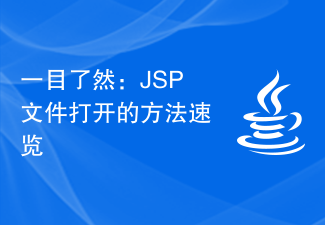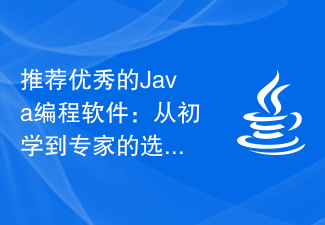 Java
Java javaTutorial
javaTutorial Start from scratch: step-by-step guide on how to configure Maven and Idea to quickly get started with development
Start from scratch: step-by-step guide on how to configure Maven and Idea to quickly get started with development
In the software development process, it is very important to have an excellent build tool and integrated development environment. Maven, as a construction tool for Java projects, can help developers uniformly manage dependencies, packaging, deployment, etc., while IntelliJ Idea is a powerful integrated development environment (IDE) that is widely used in Java development. With the theme of "Starting from Scratch: Teach You Step by Step to Configure Maven and Idea", this article will introduce how to configure Maven in Idea, and use specific code examples to help readers quickly get started with development.
1. Download and install Maven
First, we need to download and install Maven. On the Maven official website (https://maven.apache.org/), find the latest Maven version and download it. After the download is complete, follow the installation guide provided in the official documentation to install it. After the installation is complete, we need to configure Maven's environment variables.
In Windows systems, you can configure Maven's environment variables through the following steps:
- Right-click "This Computer", click "Properties", and enter the system properties;
- Click "Advanced System Settings" and click "Environment Variables" in the pop-up window;
- Create a new variable in the system variables. The variable name is "M2_HOME" and the variable value is the Maven installation path;
- In the system variable "Path", add "%M2_HOME% in".
2. Configure the Maven project
- Open Idea and create a new Java project;
- In the project, right-click "External Libraries", Select "Configure Libraries";
- Click the " " sign, select "Maven", and then configure Maven's local library path;
- In the project's pom.xml file, add the project's dependencies .
<dependencies>
<dependency>
<groupId>org.springframework</groupId>
<artifactId>spring-core</artifactId>
<version>5.1.5.RELEASE</version>
</dependency>
</dependencies>3. Run Maven command
In Idea, we can run Maven through the command line. For example, we can clean the project and generate a jar package through the command "clean install". Enter the following command in Idea's Terminal:
mvn clean install
4. Configure Maven plug-in
Idea provides rich plug-in support, which can help us develop more efficiently. In Idea, we can install Maven plug-ins through the plug-in manager. For example, installing the "Spring Assistant" plug-in can help us develop Spring projects more conveniently.
5. Writing Java Code
In Idea, we can write Java code and use Maven to manage project dependencies, packaging, deployment and other work. The following is a simple Java code example:
package com.example.demo;
public class HelloWorld {
public static void main(String[] args) {
System.out.println("Hello, Maven and Idea!");
}
}Conclusion
Through the introduction of this article, we have learned how to configure Maven and Idea, and help readers quickly get started with development through specific code examples. The powerful functions of Maven and the convenient operation of Idea can greatly improve development efficiency. I hope readers can make full use of these two tools to develop high-quality Java projects.
The above is the detailed content of Start from scratch: step-by-step guide on how to configure Maven and Idea to quickly get started with development. For more information, please follow other related articles on the PHP Chinese website!
 Flask和Intellij IDEA集成: Python web应用程序开发技巧(第二部分)Jun 17, 2023 pm 01:58 PM
Flask和Intellij IDEA集成: Python web应用程序开发技巧(第二部分)Jun 17, 2023 pm 01:58 PM在第一部分介绍了基本的Flask和IntellijIDEA集成、项目和虚拟环境的设置、依赖安装等方面的内容。接下来我们将继续探讨更多的Pythonweb应用程序开发技巧,构建更高效的工作环境:使用FlaskBlueprintsFlaskBlueprints允许您组织应用程序代码以便于管理和维护。Blueprint是一个Python模块,能够包
 推荐五款入门级手机Java编程软件,助你轻松上手Jan 09, 2024 pm 02:14 PM
推荐五款入门级手机Java编程软件,助你轻松上手Jan 09, 2024 pm 02:14 PM手机Java编程软件推荐:让你轻松入门的五款工具在这个数字化时代,手机已经成为了我们生活中不可或缺的一部分。无论是工作、学习还是娱乐,手机几乎可以满足我们所有的需求。而对于编程爱好者来说,手机也可以成为一个非常实用的工具,帮助他们随时随地进行代码编写与学习。本文将向大家推荐五款手机Java编程软件,让你轻松入门,享受编程的乐趣。AIDEAIDE是一款功能强大
 C#开发经验分享:快速开发与敏捷开发方法论Nov 23, 2023 am 09:37 AM
C#开发经验分享:快速开发与敏捷开发方法论Nov 23, 2023 am 09:37 AM在C#开发的过程中,快速开发与敏捷开发方法论都是非常重要的,尤其是在现在快速变化的市场中。在本篇文章中,我将分享我的C#开发经验,重点关注快速开发与敏捷开发的方法论。一、什么是快速开发快速开发是为了快速响应市场需求,使产品能够尽早推出。这种开发方法可以大大缩短项目的开发周期,降低成本,并能根据用户需求进行快速迭代开发。快速开发需要一些具体的技术手段,例如采用
 一目了然:JSP文件打开的方法速览Jan 31, 2024 pm 09:28 PM
一目了然:JSP文件打开的方法速览Jan 31, 2024 pm 09:28 PMJSP文件打开方式JSP(JavaServerPages)是一种动态网页技术,它允许程序员在HTML页面中嵌入Java代码。JSP文件是文本文件,其中包含HTML代码、XML标记和Java代码。当JSP文件被请求时,它会被编译成JavaServlet,然后由Web服务器执行。打开JSP文件的方法有几种方法可以打开JSP文件。最简单的方法是使用文本编辑器,
 推荐必备的Java开发软件,打造高效开发环境Feb 03, 2024 am 10:45 AM
推荐必备的Java开发软件,打造高效开发环境Feb 03, 2024 am 10:45 AM在今天的软件开发领域,Java作为一种广泛应用的编程语言,有着很高的开发效率和便捷性。为了提高开发效率,拥有一个优秀的Java编程环境是至关重要的。本文将为大家推荐几款必备的Java编程软件,帮助打造一个高效的开发环境。EclipseEclipse是一款功能强大且广泛使用的Java集成开发环境(IDE)。它提供了丰富的功能和插件,支持Java项目的开发、调试
 推荐的Java编程软件,让您的效率提升Feb 03, 2024 am 10:03 AM
推荐的Java编程软件,让您的效率提升Feb 03, 2024 am 10:03 AM随着现代工作和生活的步伐不断加快,高效工作成为每个人追求的目标。而在信息技术领域,编程成为了提升效率的重要工具之一。在众多的编程语言中,Java作为一种广泛应用的高级编程语言,其编程软件更是成为提升效率的神器。本文就为大家推荐几款优秀的Java编程软件。首先要推荐的是Eclipse。作为Java开发者最常用的集成开发环境(IDE),Eclipse具备了强大的
 推荐优秀的Java编程软件:从初学到专家的选择Feb 03, 2024 am 08:32 AM
推荐优秀的Java编程软件:从初学到专家的选择Feb 03, 2024 am 08:32 AMJava编程语言被广泛应用于各种软件开发领域,因其跨平台性能和可靠性而备受开发者青睐。然而,要进行Java编程,我们需要选择一款优秀的Java编程软件。本文就从入门到精通,推荐几款优秀的Java编程软件,帮助读者选择适合自己的工具。Eclipse(EclipseIDE)Eclipse是一个非常流行的开源集成开发环境(IDE)。它提供了强大的编辑器、调试器
 快速生成JSP文件的方法Feb 01, 2024 am 08:24 AM
快速生成JSP文件的方法Feb 01, 2024 am 08:24 AM如何快速创建JSP文件JSP(JavaServerPages)是一种基于Java的服务器端脚本技术,用于创建动态的Web页面。JSP文件以.jsp为扩展名,可以包含HTML、XML、Java代码和JSP标记。创建JSP文件的方法使用文本编辑器创建新的文本文件。在文本文件的开头添加以下代码:


Hot AI Tools

Undresser.AI Undress
AI-powered app for creating realistic nude photos

AI Clothes Remover
Online AI tool for removing clothes from photos.

Undress AI Tool
Undress images for free

Clothoff.io
AI clothes remover

AI Hentai Generator
Generate AI Hentai for free.

Hot Article

Hot Tools

Zend Studio 13.0.1
Powerful PHP integrated development environment

SublimeText3 Chinese version
Chinese version, very easy to use

SublimeText3 Linux new version
SublimeText3 Linux latest version

Notepad++7.3.1
Easy-to-use and free code editor

Dreamweaver CS6
Visual web development tools






